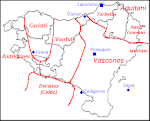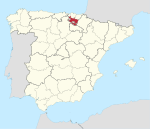Botanical Garden of Santa Catalina
2003 establishments in the Basque Country (autonomous community)Botanical gardens in SpainBuildings and structures completed in 2003Parks established in the 2000sProtected areas established in 2003 ... and 1 more
Tourist attractions in Álava

The Santa Catalina Botanical Garden (Basque: Santa Katalinako lorategi botanikoa, Spanish: Jardín botánico de Santa Catalina) is located in the municiaplity of Iruña de Oca, province of Álava, Basque Country, Spain. The garden is centered around the ruins of the Santa Catalina convent, located between the Zadorra river and the Badaia Range, close to Trespuentes.
Excerpt from the Wikipedia article Botanical Garden of Santa Catalina (License: CC BY-SA 3.0, Authors, Images).Botanical Garden of Santa Catalina
Santa Katalinako bidea/Camino de Santa Catalina, Iruña Oka/Iruña de Oca
Geographical coordinates (GPS) Address Phone number Nearby Places Show on map
Geographical coordinates (GPS)
| Latitude | Longitude |
|---|---|
| N 42.849444444444 ° | E -2.8075 ° |
Address
Santa Katalinako lorategi botanikoa/Jardín Botánico de Santa Catalina (Santa Katalinako parke botanikoa)
Santa Katalinako bidea/Camino de Santa Catalina
01191 Iruña Oka/Iruña de Oca (Trespuentes)
Autonomous Community of the Basque Country, Spain
Open on Google Maps






